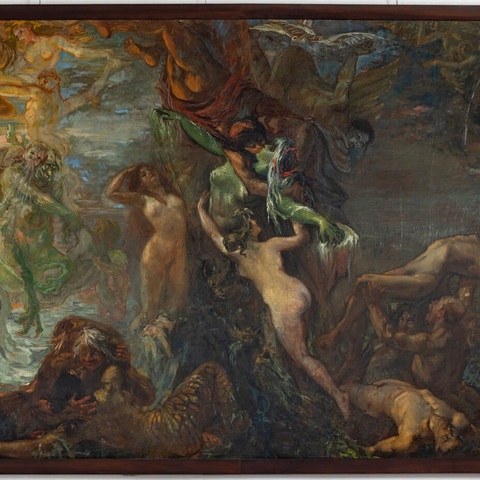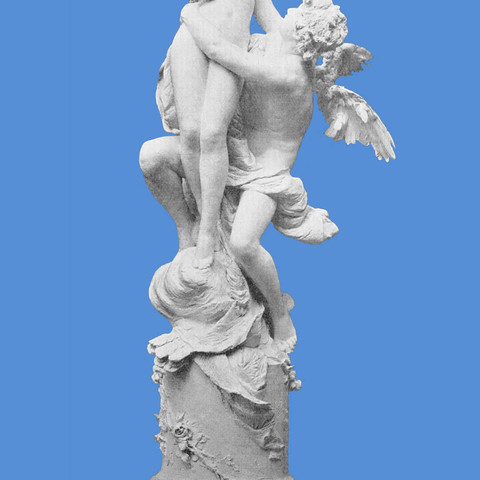Gustav H. Eberlein was born on 14 July 1847 in Spiekershausen near Hann. Münden.
In 1869 Eberlein moved to the up-and-coming imperial capital Berlin. There, as a professor, he was one of the best-known artists of the Berlin sculpture school of the 19th century. Eberlein's "great love" was Italy and his home town of Münden, from which he always drew strength for the gruelling life in Berlin.
In Münden he built two summer residences: the "Eberburg" and the "Weserkastell", which was demolished in the course of the construction of the Weser Bridge. In addition to permanent studios in Berlin and Münden, he temporarily maintained a workshop in Rome, New York, Buenos Aires and Santiago de Chile. In the period after the First World War, Eberlein came into increasing personal and artistic conflict with his environment.
He died on 5 February 1926, embittered and relatively impoverished by inflation, far from his beloved Münden in Berlin.
"Gustav Eberlein was not only a typical but also an outstanding representative of his time" (quote Prof. Dr Peter Bloch, Berlin).
Gustav Eberlein's works in Hann. Münden
The Gustav Eberlein Exhibition
With approx. 21 exemplarily selected exhibits from the fields of sculpture and painting, an impression of Gustav Eberlein's multifaceted oeuvre is to be conveyed in the Städtisches Museum. The exhibition was inaugurated in April 2017 with the opening of the museum season after an extensive redesign.
A QR code is attached to each work, which visitors can use to access a complete list of the individual exhibits on the internet and obtain further information there.
On the occasion of the 170th birthday of Gustav Eberlein in 2017, a special exhibition with an extensive accompanying programme was held in four rooms at the Städtisches Museum in cooperation with the Gustav-Eberlein-Forschung e.V. association under the motto "NEU ENTDECKEN!" from 14 July to 17 December 2017.
Afterwards, numerous exhibits were rehoused in the museum's stacks. Literature on the permanent and special exhibition is available at the museum's ticket office. Further information on the Gustav Eberlein exhibition.
Tillyschanze tower room with relief
The observation tower was built by the tower building committee, a local citizens' initiative from Münden, between 1881 and 1885 with donations.
In the upper tower room, there is a monumental relief made of plaster (2 x 2.75 m) on the wall. It depicts the heroic "Defence of the town of Münden in the 30-year war against Tilly".
The sculptor, painter and poet Gustav Eberlein (1847-1926) were responsible for the decoration of this room. The entire work was transported from the Berlin studio to Münden in several individual parts, which weighed 19 hundredweights with the packaging when wet. The coloured relief was presented to the public on the first day of Whitsun in 1888.
Eberlein included many personal items in his work of art. Besides, several of the persons depicted bear a strong resemblance to people close to him. His father, mother, friends and relatives are depicted here as warriors, wounded soldiers and citizens.
In the lower-left margin, Eberlein signed his work with a self-portrait in the form of an oval medallion.
In 2011, penetrating moisture from the leaking terrace floor above the tower room threatened to destroy the work of art. Thanks to the Schutz- und Fördergemeinschaft Tillyschanze e.V., the tower room was thoroughly renovated from 2011. The sculptor and painter Erhard Joseph (Adelebsen) restored the relief and freshened up the colours so that the tower room could be reopened in 2017 for the 170th birthday of Gustav Eberlein.
The relief is now protected from vandalism by a railing made of glass and stainless steel.
A photo of the relief is mounted on the interactive display in front of it. By pressing on selected zones (14 in total), one receives explanations in German and English.
"God the Father Breathes Breath into Adam".
Carrar marble / height figure 300 cm, sandstone base 80 cm / signed lower left: G. Eberlein, ROMA 1904 / location: Schlesierplatz (near railway station)
The larger-than-life marble statue "God the Father" was acquired by the town of Münden in 1927 from the Berlin estate of the artist, who was born in 1847 and died in 1926, from the brothers Karl and Heinrich Fischer (Münden factory owners). They donated the colossal work to the town. To protect it from acid rain, it received a glass roof in 2012.
Eberlein found models for this Genesis depiction in Italian art. Michelangelo, for example, had reproduced it almost 400 years earlier in the sequence of images created as the centrepiece on the ceiling of the Sistine Chapel. From God's outstretched index finger on the right hand, the life-giving spark jumps over to the index finger on Adam's left hand. Eberlein transforms this revival event into the form of an invigorating, implied kiss. His sculptural representation is not known again.
In the Museum Hann. Münden, a hard plaster bottom can be seen as a preliminary study of the marble version, only 47 cm high, in the permanent exhibition of the Eberlein department. In a bronze dated and signed 1897, this bottom can be found as a cast in the Alte Nationalgalerie in Berlin. Other important works by Eberlein can be seen there, including the marble version of the "Dornausziehers", the plaster original of which is in the Hann. Münden Museum.
As a life-size bronze from 1898, the God the Father group was rediscovered at the beginning of 2019 in the Staatsbibliothek Zu Berlin (Prussian Cultural Heritage). Its original plaster design of the same size was lost in the Münden Museum.
Weser Song Complex - bronze reliefs Gustav Pressel and Franz von Dingelstedt
This monument is intended to honour the creators of the well-known Weser Song. Both portrait heads (design and casting, 1914) are framed by a large colourful wreath of leaves - half laurel, half oak. In the case of Franz von Dingelstedt, Eberlein has interwoven some roses at the bottom of the oak wreath because the Weser Song is a love song. Prof. Eberlein had already presented the first suggestions for a tribute to the two creators of the Weser Song to the town of Münden in 1905. With these words, he once again demonstrated his love of his homeland.
Three Crucifixes in the Lutheran Churches of St. Blasius (Hann. Münden), St. Elisabeth (Nienhagen) and St. Marien (Spiekershausen)
The Christian religion had a deep meaning for Gustav Eberlein. This is evidenced by the diverse pictorial works that Eberlein designed based on themes from the Bible. Unfortunately, many of them were destroyed and are known to posterity only from illustrations. Nevertheless, three crucifixes by the artist have survived in the Hann. Münden area and can be visited. What is particularly interesting here is that the artistic expression also shows the stylistic change in the course of his life. The Christian symbol of the crucified Saviour occupied the artist very intensively in all phases of his life.
Between 1866 and 1898 he made the three crucifixes described below, which are still preserved and can be found in churches in Hann. Münden and the surrounding area. These show the development from the classical, idealising formal language of his younger years to the naturalistic, expressive style at the height of his artistic career. Unfortunately, the last crucifix from 1924 has not survived.












